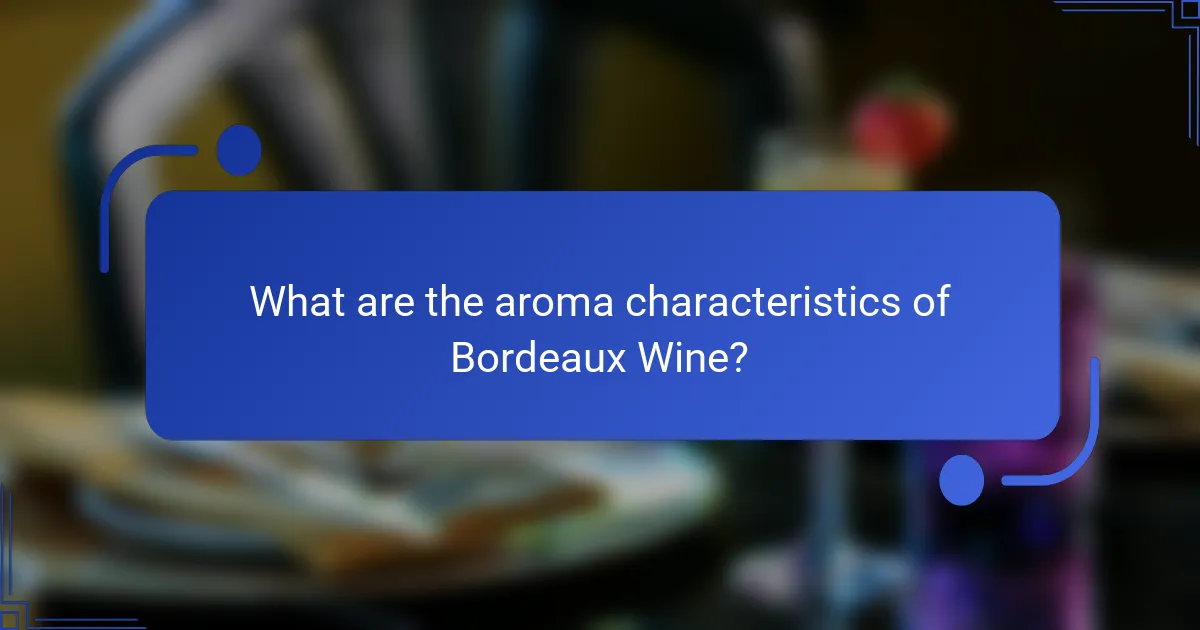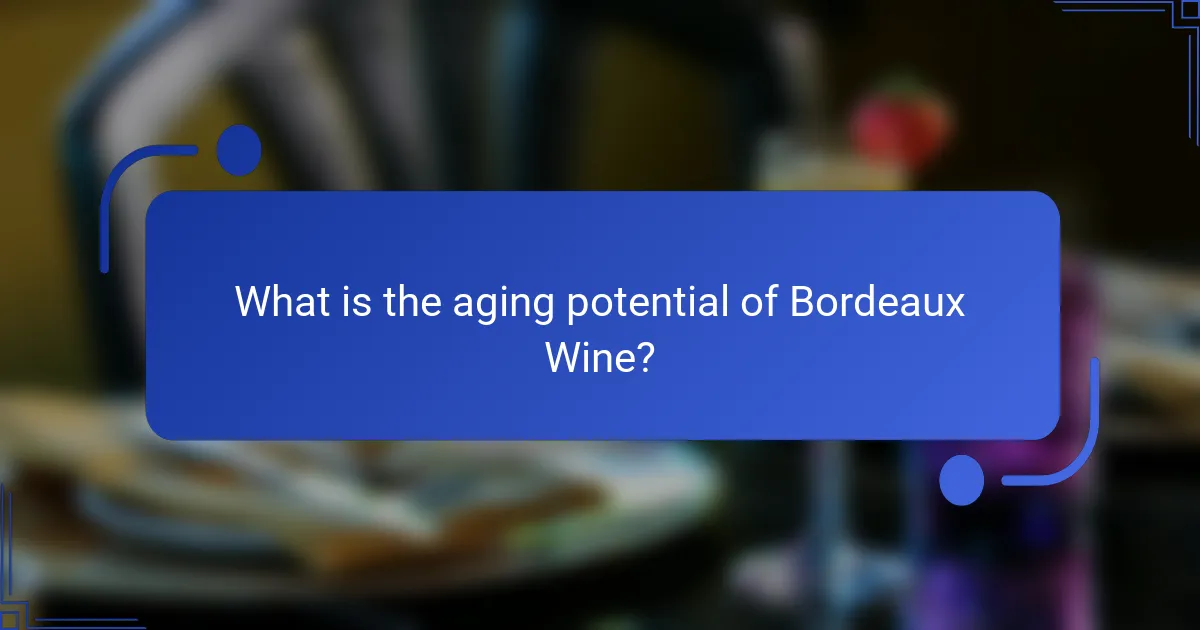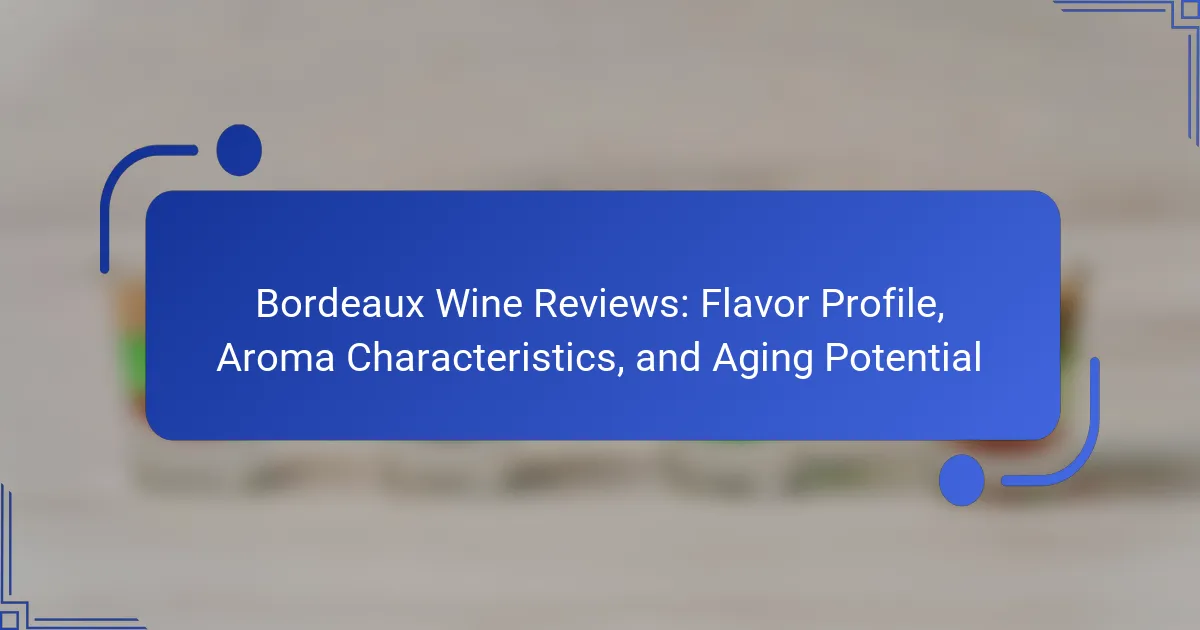
What is Bordeaux Wine?
Bordeaux wine is a prestigious type of wine produced in the Bordeaux region of France. This region is renowned for its unique blend of grape varieties, primarily Merlot, Cabernet Sauvignon, and Cabernet Franc. Bordeaux wines are characterized by their rich flavors and aromas, often displaying notes of dark fruit, cedar, and spice. The region’s climate and soil contribute to the wine’s complexity and aging potential. Bordeaux wines are classified into various categories, including red, white, and sweet wines. The classification system, established in 1855, ranks wines based on their quality and reputation. Bordeaux wines are highly regarded globally and often fetch high prices at auctions.
How is Bordeaux Wine classified?
Bordeaux wine is classified primarily by its regions and the quality of its vineyards. The classification system includes several categories such as the Bordeaux AOC, Cru Bourgeois, and the 1855 Classification. Bordeaux AOC includes wines from the entire Bordeaux region. Cru Bourgeois wines are recognized for their quality but are not classified as First Growths. The 1855 Classification ranks wines into five growths based on historical reputation and price. First Growths are the highest-rated wines, like Château Lafite Rothschild. Each classification reflects the vineyard’s reputation and the wine’s quality. This classification system has been in place since the mid-19th century and remains influential today.
What are the key regions within Bordeaux?
The key regions within Bordeaux are Médoc, Saint-Émilion, Pomerol, Graves, and Sauternes. Médoc is known for its Cabernet Sauvignon-dominant wines. Saint-Émilion produces Merlot-based blends that are highly regarded. Pomerol is famous for its rich, velvety Merlot wines. Graves is recognized for both red and white wines, with a focus on Cabernet Sauvignon and Sauvignon Blanc. Sauternes is celebrated for its sweet dessert wines made from botrytized grapes. Each region has distinct terroirs that influence the flavor profiles and characteristics of the wines produced.
What types of grapes are commonly used in Bordeaux Wine?
Bordeaux wine commonly uses Cabernet Sauvignon, Merlot, and Cabernet Franc grapes. These grape varieties are essential to the region’s wine production. Cabernet Sauvignon is known for its bold flavor and tannins. Merlot contributes softness and fruitiness to the blend. Cabernet Franc adds aromatic complexity and herbal notes. Other less common varieties include Petit Verdot and Malbec. Bordeaux’s climate and soil conditions favor these grapes, enhancing their unique characteristics. The blending of these varieties creates the signature style of Bordeaux wines.
What are the historical influences on Bordeaux Wine?
Bordeaux wine has been shaped by several historical influences. The region’s winemaking dates back to the Roman era, around the 1st century AD. Romans introduced viticulture techniques that laid the foundation for future production. In the Middle Ages, Bordeaux became a significant trading port. This facilitated the export of wine, enhancing its reputation. The 18th century saw the rise of claret, a style that gained popularity in England. This period marked the beginning of Bordeaux’s global influence. The classification system established in 1855 further defined Bordeaux’s quality hierarchy. This system is still in use today, influencing market value and prestige. Additionally, phylloxera in the late 19th century prompted major replanting and innovation in viticulture. These historical events collectively shaped the identity and global standing of Bordeaux wine.
How has Bordeaux Wine evolved over the centuries?
Bordeaux wine has evolved significantly over the centuries. Initially, in the Roman period, it was primarily produced for local consumption. By the 12th century, Bordeaux gained prominence as a key wine trade center, particularly with England. The introduction of new grape varieties and winemaking techniques occurred in the 17th century. This period marked the beginning of Bordeaux’s reputation for quality wines. In the 19th century, the phylloxera crisis led to the replanting of vineyards with hybrid varieties. The 20th century saw the establishment of strict classification systems, enhancing quality control. Today, Bordeaux wine is renowned globally for its complex flavors and aging potential. Its evolution reflects advancements in viticulture and changing market demands.
What role do local traditions play in Bordeaux Wine production?
Local traditions significantly influence Bordeaux wine production. These traditions dictate vineyard management practices, including grape selection and cultivation methods. Bordeaux’s winemaking heritage emphasizes specific grape varieties like Merlot and Cabernet Sauvignon. Traditional fermentation techniques, such as using oak barrels, enhance flavor complexity. Local customs also shape harvest timing, often aligning with regional festivals. The influence of terroir, a concept rooted in local tradition, affects the wine’s character. Bordeaux’s classification system reflects historical practices and regional pride. Overall, local traditions ensure the preservation of Bordeaux’s unique wine identity.
What are the primary characteristics of Bordeaux Wine?
Bordeaux wine is characterized by its complex flavor profile, balanced acidity, and rich tannins. The primary grape varieties used are Merlot, Cabernet Sauvignon, and Cabernet Franc. Bordeaux wines typically exhibit flavors of dark fruits, such as blackberry and plum. They often have herbal and earthy notes, contributing to their complexity. The wines are known for their aging potential, often improving over 10 to 20 years. Bordeaux wines are classified into several categories, including red, white, and sweet wines. The region’s unique terroir influences the wine’s characteristics, including soil composition and climate. Bordeaux’s winemaking tradition dates back to Roman times, establishing its reputation in the wine world.
What flavors can one expect from Bordeaux Wine?
Bordeaux wine typically offers a complex flavor profile. Common flavors include dark fruits like blackberry and blackcurrant. You may also detect notes of plum and cherry. Additionally, Bordeaux wines often have earthy undertones. These can include hints of leather, tobacco, and forest floor. Spicy notes from oak aging are also prevalent. These may manifest as vanilla, clove, or cedar. The balance of these flavors can vary by vintage and blend.
How do climate and terroir influence Bordeaux Wine characteristics?
Climate and terroir significantly influence Bordeaux wine characteristics. The climate in Bordeaux is maritime, with moderate temperatures and ample rainfall. This environment allows grapes to ripen evenly, contributing to balanced acidity and sugar levels. Terroir encompasses soil composition, drainage, and topography, which affect grape health and flavor expression. Bordeaux’s diverse terroirs include clay, limestone, and gravel soils, each imparting unique mineral qualities to the wine. For example, clay retains moisture, benefiting Merlot, while gravel warms and drains well, favoring Cabernet Sauvignon. These elements combined create a range of flavors, aromas, and aging potentials in Bordeaux wines.

What are the flavor profiles of Bordeaux Wine?
Bordeaux wine exhibits a complex flavor profile characterized by dark fruits, earthiness, and oak. Common flavors include blackcurrant, plum, and cherry. Earthy notes like leather and tobacco are often present. Oak aging contributes vanilla, spice, and toast flavors. The wine’s structure is marked by firm tannins and balanced acidity. Bordeaux wines can also exhibit herbal and floral nuances. These flavor profiles vary depending on the grape varietals used, such as Cabernet Sauvignon, Merlot, and Cabernet Franc. The terroir of Bordeaux, with its diverse soils and microclimates, significantly influences these flavors.
What are the common flavor notes found in Bordeaux Wine?
Bordeaux wine commonly features flavor notes of blackcurrant, plum, and cherry. These fruits are often complemented by earthy undertones and herbal notes. Common secondary flavors include tobacco, cedar, and leather. Bordeaux wines also exhibit hints of vanilla and spice from oak aging. The flavor profile can vary based on the blend and region within Bordeaux. For example, Merlot-dominant wines tend to be softer and fruitier, while Cabernet Sauvignon-dominant wines are often more structured and tannic. The complexity of flavors in Bordeaux wines develops with aging, enhancing their aromatic characteristics.
How do red Bordeaux Wines differ in flavor from white Bordeaux Wines?
Red Bordeaux wines typically have a richer, fuller flavor profile compared to white Bordeaux wines. Red Bordeaux is primarily made from grape varieties like Cabernet Sauvignon and Merlot. These grapes contribute to flavors of dark fruits, such as blackberry and plum. Additionally, red Bordeaux often features notes of spices, tobacco, and leather due to aging in oak barrels.
In contrast, white Bordeaux wines are usually crafted from Sauvignon Blanc and Sémillon grapes. They exhibit lighter, crisper flavors, including citrus, green apple, and floral notes. The acidity in white Bordeaux tends to be higher, providing a refreshing quality.
The aging process also differs. Red Bordeaux wines can age longer, developing more complex flavors over time. White Bordeaux wines are generally enjoyed younger, although some can also age well. This distinction in grape varieties and aging influences the overall taste experience of each wine type.
What role does aging play in the development of flavors?
Aging significantly enhances the development of flavors in Bordeaux wine. During aging, chemical reactions occur that transform the wine’s primary fruit flavors into more complex secondary and tertiary notes. These reactions include oxidation, which softens tannins and integrates flavors. The process also allows for the extraction of compounds from oak barrels, adding vanilla, spice, and toast characteristics.
Research indicates that wines aged for longer periods can develop flavors such as leather, earth, and mushroom, which are not present in younger wines. A study by the University of California, Davis, found that aging can improve the aromatic profile of wines, making them more appealing to consumers. Thus, aging plays a crucial role in enriching the flavor complexity of Bordeaux wines.
How do different Bordeaux regions affect flavor profiles?
Different Bordeaux regions significantly influence the flavor profiles of wines produced there. The Left Bank, particularly areas like Médoc, is known for Cabernet Sauvignon dominance. This results in wines that are full-bodied with dark fruit flavors and structured tannins.
In contrast, the Right Bank, including regions like Saint-Émilion, predominantly features Merlot. This leads to softer, fruitier wines with notes of plum and chocolate.
The terroir, including soil composition and climate, also plays a crucial role. The gravelly soils of the Left Bank enhance drainage, benefiting Cabernet Sauvignon. Conversely, the clay-rich soils of the Right Bank retain moisture, favoring Merlot cultivation.
Specific regions like Pomerol are renowned for their rich, velvety textures and earthy undertones. Meanwhile, wines from Graves often exhibit a unique smokiness due to the region’s distinct soil.
Overall, the interplay of grape variety, terroir, and regional characteristics creates diverse and complex flavor profiles in Bordeaux wines.
What unique flavors are associated with wines from the Left Bank?
Wines from the Left Bank are known for their unique flavors of blackcurrant, cedar, and tobacco. These flavors stem from the predominant grape varieties used, primarily Cabernet Sauvignon. The gravelly soil of the Left Bank enhances the ripeness and concentration of these flavors. Additionally, many wines exhibit notes of plum, leather, and spice. The aging process in oak barrels adds complexity, introducing hints of vanilla and toast. These characteristics are consistent across renowned appellations like Margaux and Pauillac. The unique terroir contributes significantly to the flavor profile of these wines.
What distinct characteristics do Right Bank Bordeaux Wines exhibit?
Right Bank Bordeaux Wines are known for their Merlot dominance. These wines typically exhibit a softer, fruit-forward profile. They often feature flavors of plum, cherry, and chocolate. Right Bank wines tend to have a velvety mouthfeel. The tannins are generally smoother compared to Left Bank counterparts. Additionally, they can show earthy and herbal notes. Aging potential is significant, often lasting 10 to 20 years. Notable regions include Saint-Émilion and Pomerol, which are renowned for their quality.
How can one identify the flavor profile of a Bordeaux Wine?
To identify the flavor profile of a Bordeaux wine, one should assess its key attributes. Bordeaux wines typically exhibit a range of flavors including blackcurrant, plum, and cherry. These flavors often come from the predominant grape varieties such as Cabernet Sauvignon and Merlot.
Additionally, Bordeaux wines can display earthy notes, such as tobacco and leather. These characteristics are influenced by the region’s terroir and winemaking techniques. The aging process also contributes to the flavor profile, with oak aging adding vanilla and spice notes.
Tasting and smelling the wine can reveal its complex aroma characteristics. Swirling the wine in the glass helps release its bouquet. Noting the initial aromas and flavors can guide one in identifying the profile.
The wine’s finish, or aftertaste, is another important aspect. A long, lingering finish often indicates a high-quality Bordeaux. Understanding these elements is essential for accurately identifying the flavor profile of a Bordeaux wine.
What tasting techniques can enhance flavor identification?
Tasting techniques that can enhance flavor identification include systematic tasting, sensory evaluation, and palate cleansing. Systematic tasting involves evaluating wines in a controlled order to identify distinct flavors. Sensory evaluation focuses on using all senses, including sight, smell, and taste, to discern flavor nuances. Palate cleansing between tastings helps reset the taste buds, allowing for clearer identification of flavors. Research indicates that systematic approaches improve flavor recall and recognition, enhancing the overall tasting experience.
How does food pairing influence the perception of Bordeaux Wine flavors?
Food pairing significantly influences the perception of Bordeaux wine flavors. The combination of food and wine can enhance or diminish specific taste attributes. For example, fatty foods can soften tannins in Bordeaux wines, making them taste smoother. This interaction can elevate the fruitiness of the wine, creating a more balanced experience. Conversely, pairing Bordeaux with overly salty or spicy foods can overshadow its nuanced flavors. Research indicates that complementary flavors in food can amplify the wine’s aromatic profile, resulting in a richer tasting experience. Therefore, thoughtful food pairing is essential for fully appreciating Bordeaux wine’s complexity.

What are the aroma characteristics of Bordeaux Wine?
Bordeaux wine exhibits a complex aroma profile characterized by dark fruits, earthy notes, and floral undertones. Common aromas include blackcurrant, plum, and cherry, which are prominent in red Bordeaux wines. Additionally, these wines often present herbal qualities such as cedar and tobacco. Oak aging contributes vanilla, spice, and toasted nuances to the aroma. Bordeaux whites typically feature citrus, stone fruits, and floral scents. The overall aromatic complexity evolves with aging, revealing secondary notes of leather and truffle. These characteristics reflect the diverse terroirs and grape varieties of the Bordeaux region.
What are the typical aroma notes in Bordeaux Wine?
Bordeaux wine typically exhibits aroma notes of dark fruits, such as blackcurrant and plum. These wines often have hints of cedar and tobacco, contributing to their complexity. Earthy undertones, including leather and forest floor, are also common. Additionally, floral notes like violet may be present. The aging process enhances these aromas, introducing nuances of vanilla and spice from oak barrels. Overall, the aromatic profile of Bordeaux wine is rich and multifaceted, reflecting its diverse grape varieties and terroir.
How do aroma characteristics differ between red and white Bordeaux Wines?
Red Bordeaux wines typically exhibit aromas of dark fruits, such as blackcurrant and plum. They may also present notes of spices, tobacco, and earthy undertones. In contrast, white Bordeaux wines generally showcase aromas of citrus fruits and stone fruits, like pear and peach. They can also have floral notes and hints of herbs. The primary grapes used in red Bordeaux, such as Cabernet Sauvignon and Merlot, contribute to their robust and complex aroma profile. White Bordeaux wines, made mainly from Sauvignon Blanc and Sémillon, tend to have a fresher and lighter aromatic character. These differences arise from the grape varieties used and the winemaking processes involved.
What factors contribute to the aromatic profile of Bordeaux Wines?
The aromatic profile of Bordeaux wines is influenced by several key factors. These factors include grape variety, terroir, and winemaking techniques. Bordeaux wines commonly feature grape varieties such as Cabernet Sauvignon, Merlot, and Cabernet Franc. Each variety contributes distinct aromas, such as blackcurrant from Cabernet Sauvignon and plum from Merlot.
Terroir, which encompasses soil type, climate, and vineyard location, significantly impacts the wine’s aroma. For instance, the gravelly soils of the Médoc region enhance the aromatic complexity of the wines produced there.
Winemaking techniques also play a crucial role. Techniques like oak aging impart additional aromas, including vanilla and spice, while fermentation temperature can influence the extraction of aromatic compounds.
Research indicates that these elements together create the unique and diverse aromatic profiles characteristic of Bordeaux wines.
How does aging impact the aroma of Bordeaux Wine?
Aging significantly enhances the aroma of Bordeaux wine. As Bordeaux wine matures, complex aromatic compounds develop. These compounds include tertiary aromas such as earthiness, leather, and truffle. The aging process allows the wine to integrate flavors more harmoniously. Oxidation during aging contributes to a richer bouquet. Additionally, the interaction between tannins and aromatic compounds evolves over time. Studies show that well-aged Bordeaux can exhibit a range of aromas, from floral to savory notes. This transformation typically occurs over several years in optimal storage conditions.
What changes occur in aroma profiles as Bordeaux Wines age?
As Bordeaux wines age, their aroma profiles evolve significantly. Young Bordeaux wines typically exhibit vibrant fruit aromas, such as blackcurrant, cherry, and plum. Over time, these fruity notes soften and become more complex. Aging introduces secondary aromas like cedar, tobacco, and leather. These characteristics arise from the interaction of wine with oak barrels and the natural aging process. Additionally, tertiary aromas such as earthy notes, mushroom, and dried herbs develop. Studies show that the aging process enhances the wine’s bouquet, leading to a more harmonious and nuanced aroma profile. The transition from fresh fruit to complex, layered aromas is a hallmark of well-aged Bordeaux wines.
How can one assess the aroma of a Bordeaux Wine effectively?
To assess the aroma of a Bordeaux wine effectively, one should begin by using proper glassware. A tulip-shaped glass helps concentrate the aromas. Next, gently swirl the wine to release volatile compounds. This action increases the wine’s surface area, enhancing aroma release. After swirling, bring the glass to your nose and take a short inhalation. This technique allows for a better capture of the wine’s aromatic profile.
Bordeaux wines typically exhibit a range of aromas, including dark fruits, oak, and earthiness. Identifying these notes involves focusing on specific scents during the sniffing process. It can be helpful to take mental notes of the aromas detected. Engaging in this practice enhances the overall tasting experience.
Research indicates that aroma assessment is crucial for understanding wine quality. A study published in the Journal of Wine Research highlights the importance of aroma in wine evaluation. It states that trained tasters can identify over 30 distinct aroma compounds in Bordeaux wines. This demonstrates the complexity and richness of Bordeaux’s aromatic profile.
What are the best practices for appreciating Bordeaux Wine aromas?
To appreciate Bordeaux Wine aromas, first, use a proper glass. A tulip-shaped glass enhances aroma concentration. Next, observe the wine’s color against a white background. This helps in assessing clarity and depth. Swirl the wine gently to aerate it. Aeration releases volatile compounds, enhancing aroma perception. Bring the glass to your nose and inhale deeply. Focus on identifying primary scents like fruit, floral, and earthy notes. Take your time to analyze the aromas. Bordeaux wines often exhibit complex layers that evolve over time. Finally, note how the aromas change as the wine breathes. This dynamic aspect is crucial for full appreciation.
How should Bordeaux Wine be served to enhance aroma?
Bordeaux wine should be served at a temperature between 60°F and 65°F (15°C to 18°C) to enhance its aroma. Serving it too cold can mute its complex scents. Using a large, tulip-shaped glass allows for better aeration. The shape of the glass helps concentrate the aromas. Pouring a small amount allows for swirling, which releases more fragrance. Allowing the wine to breathe for at least 30 minutes before serving enhances its bouquet. Decanting older Bordeaux can help separate sediment and improve aroma. These methods are widely recommended by sommeliers and wine enthusiasts.
What glassware is ideal for experiencing the aromas of Bordeaux Wine?
The ideal glassware for experiencing the aromas of Bordeaux wine is a Bordeaux wine glass. This type of glass typically has a tall, wide bowl and a narrow rim. The design allows for optimal aeration of the wine. It enhances the release of complex aromas. The wide bowl provides space for swirling, which further intensifies scent. The narrow rim directs aromas towards the nose. Studies show that proper glass shape significantly affects aroma perception. Therefore, using a Bordeaux wine glass improves the overall tasting experience.

What is the aging potential of Bordeaux Wine?
Bordeaux wine has significant aging potential, often lasting several decades. The best Bordeaux wines, particularly those from esteemed regions like Médoc and Saint-Émilion, can age for 10 to 50 years. Factors influencing aging include the wine’s tannin structure, acidity, and fruit concentration. High-quality Bordeaux typically has robust tannins, which help preserve the wine over time. Additionally, proper storage conditions enhance aging potential. Studies show that wines like Château Lafite Rothschild can improve for over 50 years. This aging allows complex flavors to develop, enriching the wine’s profile.
How does aging affect the quality of Bordeaux Wine?
Aging significantly enhances the quality of Bordeaux wine. Over time, chemical reactions occur within the wine. These reactions lead to the development of complex flavors and aromas. Tannins soften, resulting in a smoother mouthfeel. The wine’s acidity balances, creating a harmonious profile. Additionally, aging allows for the integration of flavors from oak barrels. This process can introduce notes of vanilla, spice, and toast. Bordeaux wines typically benefit from aging between 5 to 30 years, depending on the specific wine. Studies show that well-aged Bordeaux wines can reach peak quality, showcasing depth and elegance.
What factors determine the aging potential of a Bordeaux Wine?
The aging potential of a Bordeaux wine is determined by its tannin structure, acidity, and fruit concentration. Tannins provide the necessary backbone for longevity. Higher acidity helps preserve the wine and enhances its freshness over time. Concentrated fruit flavors contribute to complexity as the wine ages. Additionally, the quality of the grapes and the winemaking process play crucial roles. Bordeaux wines made from Cabernet Sauvignon and Merlot typically exhibit better aging potential. Historical data shows that well-structured Bordeaux can age for several decades, developing nuanced flavors and aromas.
Which Bordeaux Wines are known for exceptional aging potential?
Bordeaux wines known for exceptional aging potential include Château Lafite Rothschild, Château Margaux, and Château Latour. These wines are renowned for their complex flavors and robust structures. Château Lafite Rothschild, for instance, can age for over 50 years. Its high tannin content and acidity contribute to its longevity. Château Margaux is similarly celebrated, often maturing gracefully for decades. The wine’s aromatic complexity enhances over time. Château Latour is another standout, known for its powerful profile. It benefits from long-term cellaring, developing rich and layered flavors. These wines consistently receive high scores from critics, reinforcing their reputation for aging potential.
What are the signs of a well-aged Bordeaux Wine?
A well-aged Bordeaux wine exhibits deep color, often transitioning from vibrant red to garnet or brick hues. The aroma develops complexity, revealing notes of dried fruits, leather, and earthy undertones. On the palate, it showcases smooth tannins and a balanced acidity, indicating maturity. The finish is long and nuanced, often with hints of spice or tobacco. These characteristics are typically achieved after several years of aging, allowing the wine to evolve. Studies show that Bordeaux wines can improve for 10 to 30 years, depending on the vintage and storage conditions.
How can one evaluate the aging process of Bordeaux Wine over time?
To evaluate the aging process of Bordeaux wine over time, one must assess its color, aroma, and taste. The color changes from deep purple to garnet as it ages. Aromas evolve from fruity to more complex notes like leather and earth. Tasting reveals a transition from bold tannins to a smoother, integrated profile. Evaluators often use a systematic approach, including tasting at different intervals. Research shows that Bordeaux wines can age well for 10 to 50 years, depending on the vintage and storage conditions. Specific vintages, like 2000 and 2005, are noted for their aging potential. This systematic evaluation provides insights into the wine’s development over time.
What are the risks associated with aging Bordeaux Wine?
Aging Bordeaux wine carries several risks. One significant risk is oxidation. This occurs when the wine is exposed to too much air, leading to a loss of flavor and aroma. Another risk is cork taint. This defect can spoil the wine, often caused by a compound called TCA. Additionally, improper storage conditions can lead to spoilage. High temperatures can accelerate aging, while excessive humidity can damage labels and corks. Furthermore, over-aging can result in a wine losing its desirable characteristics. Research indicates that Bordeaux wines typically peak between 10 to 30 years of aging. Beyond this range, the wine may decline in quality.
What tips can help in selecting Bordeaux Wines for aging?
Select Bordeaux wines with high tannin levels for aging. Tannins provide structure and longevity. Look for wines labeled as “Grand Cru” or “Cru Classé.” These wines often have better aging potential. Consider vintages known for longevity, such as 2005, 2009, and 2010. These years produced wines that age gracefully. Check the wine’s acidity; higher acidity can enhance aging potential. Seek out blends that include Cabernet Sauvignon, which is known for its aging ability. Finally, ensure proper storage conditions to maintain wine quality over time.
How should Bordeaux Wines be stored for optimal aging?
Bordeaux wines should be stored in a cool, dark, and humid environment for optimal aging. Ideal storage temperature ranges from 50 to 55 degrees Fahrenheit. Consistent temperature is crucial; fluctuations can damage the wine. Humidity levels should be around 70% to prevent corks from drying out. Bordeaux wines should be stored horizontally to keep the cork moist. Light exposure should be minimized, as UV rays can degrade the wine. Vibration should be avoided, as it can disturb the sediment and affect aging. Proper storage conditions can significantly enhance the aging potential of Bordeaux wines.
What is the ideal timeframe for aging different types of Bordeaux Wines?
The ideal timeframe for aging different types of Bordeaux wines varies significantly. Red Bordeaux wines typically age well for 5 to 30 years. This depends on the blend and quality of the wine. Higher-quality vintages can often age for over 20 years.
White Bordeaux wines generally have a shorter aging potential. They are best consumed within 2 to 10 years. Certain high-quality white Bordeaux can age longer, up to 15 years.
The aging process enhances complexity and depth of flavor in Bordeaux wines. Factors such as grape variety, vineyard location, and vintage also influence aging potential.
Bordeaux wine is a prestigious type of wine produced in the Bordeaux region of France, known for its unique blend of grape varieties such as Merlot, Cabernet Sauvignon, and Cabernet Franc. This article reviews the flavor profiles, aroma characteristics, and aging potential of Bordeaux wines, detailing their classification systems, key regions, and the influence of climate and terroir on their development. Additionally, it explores the historical influences that have shaped Bordeaux wine production and provides insights into the tasting techniques and food pairings that enhance the wine experience. The article also addresses the factors determining aging potential and the best practices for selecting and storing Bordeaux wines for optimal quality.
